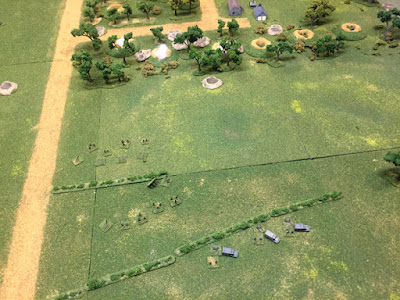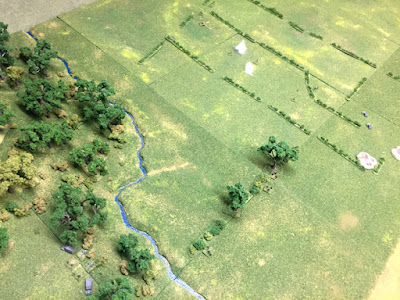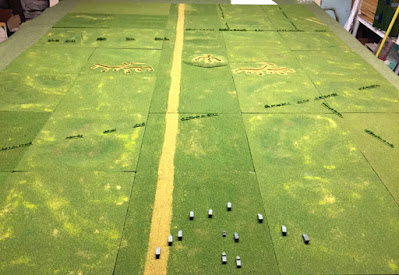Fire in the East map, hex 2822, Lithuanian border, somewhat west of Kaunas. German and Soviet reconnaissance forces clash in the opening minutes of the offensive:
The German forces advance across the border on their bicycles, leaving the unmanned checkpoint behind them, they passed through a forested area and approached a small bridge. Maybe a thousand meters ahead of them where some farm buildings, and likely Soviet forces. The young lietenant looked skyward on hearing the engine noise above him, and felt comfort in seeing the Messerschmitts high above.
Looking through his binoculars, he scanned the farm for signs of the enemy and wondered what lie ahead.
German Forces
Elements of the 2nd Recce Btln, 2nd Infantry Division
1x Recce Compny (Bicycle)
1x CHQ w/ HQ section, 2x MG sections, Kubelwagen, Truck
3x Recce Pltn w/ PHQ, 3x Recce Section, 1x ATR
1x Support Pltn w/ PHQ, 3x 5cm Mortar
1x Recce Support Company
1x HQ section, Kubelwagen
1x ATG Pltn w/ 3x 3.7cm PaK 36, 3x Truck
1x Gun Pltn w/ 2x 7.5cm IG 18, 2x truck
1x Arm. Car Pltn w/ 2x Kfz 13
Soviet Forces
The 9th Recce Company and 11th NKVD Company greet the Germans.
9th Recce Company
1x CHQ w/ HQ section
3x Recce Pltn w/ PHQ, 3x Recce Section, 1x 5cm Mortar, 3x Truck
11 NKVD Company
1x CHQ w/ HQ section
3x NKVD Rifle Pltn w/ PHQ, 3x Rifle Section
The Battlefield
The battlefield is located in FitE map hex 2822, slightly east of the border with East Prussia and west of Kaunas.
The Battle
The Soviet NNKVD Company was deployed south of the road at the eastern edge of a lightly forested area surrounded by farm fields. The Recce Company was deployed north of the central road along foliage lines separating farm fields.
The Germans advanced along the road, lead by the bicycle company of the 2nd Recce Btln of the 2nd ID. Just the first German troops started to cross the little bridge of the creek, they spotted the Soviet Recce troops just north of the road and immediately started to deploy off road.
One platoon of bicycle troops deployed immediately north of the bridge, while two platoons moved south. Both German company HQs deployed a little behind the trees to the north of the bridge, while the 7.5cm infantry guns deployed along the stream ahead of the HQ sections, and the 3.7cm anti-tank guns advanced to support the bicycle troops south of the road.
The two Kfz 13 armored cars were temporarily held at the HQs, and two batteries of 10.5cm artillery awaited fire support orders.
The bicycle troops south of the bridge advanced from one field line to the next, until taking fire from the tree line in front of them. Additionally, they took fire from Soviet recce troops north of the road, but took no casualties.
The Soviet recce troops started to receive fire from the German 10.5cm batteries and quickly took casualties at their southernmost point. Immediately after this, the bicycle troops to the south started to take more fire from the tree line and the 10.5cm guns were re-directed to fire there.
During this time, the German 3.7cm AT guns were moved into position south of the bicycle troops and began firing at the Soviet infantry positions in the trees. Slowly, hits were scored against the NKVD troops dug in along the tree line. The German 5cm mortar section tried to hit the Soviet positions also, but struggled to get within range.
To the north, the 7.5cm guns began firing at the Soviets in the field lines, while infantry on both sides sporadically engaged each other without causing much damage. Eventually the infantry guns scored a couple of hits, as did the NKVD troops against the German bicycle troops south of the road.
Soviet fire from the tree line began to fade and the bicycle troops advanced.
The bicycle troops eventually made their way to the tree line, while artillery and ATGs fired away at the soviet positions further south. Soviet rifle fire killed a German rifle section and one ATR during the advance.
To the north, the German bicycle platoon moved north along the stream bed, and then east along the foliage and trees to gain better view and range on the soviet recce forces. Additionally, the two infantry guns re-deployed further north on the west side of the stream to support the bicycle troops.
Between the infantry guns and the bicycle troops, the Soviets were slowly whittled away, during this time, the two Kfz 13s advanced down the road and swung north to encircle the Soviet recce troops. The Soviet troops were unable to score any hits on the Kfz 13s, while taking a number of casualties, with several sections eventually surrendering to the armored cars.
To the south, German troops advance into the Soviet fighting pits and exchanged fire with the NKVD troops. In the face of the advancing German artillery, the southern most NKVD section eventually threw down their weapons and ran into the woods. The remaining NKVD platoon in the woods along the road finally retreated after watching the Germans church their way forward and losing contact with their CHQ.
The germans rounded up the Soviet prisoners in the field, tended to their wounded, and regrouped before continuing forward,
In all, the germans lost only two sections, one rifle, and one anti-tank rifle. The Soviets lost both companies, with 8 NKVD sections killed, and 11 recce sections killed and the remaining five captured.
In a state of panic, one NKVD section simply evaporated into the countryside, and the withdrawing platoon will likely either be shot by their own troops or overrun by these same Germans later in the day.
Other Tidbits
The Soviets did not experience the German pre-attack artillery bombardment, so were intact when the Germans discovered their presence. Tthe Germans on the bridge were sighted on the same turn that they first saw the Soviets, the Soviets simply had no weapons with which to hit the Germans at 800 plus meters range.
Additionally, the Soviet 9th Infantry Brigade lost most of its headquarters in the early German air attacks, and could not receive notification of the of the German advance here, nor could they offer any artillery or other support.
The Soviet recce troops could not disengage with the Germans, as once they were off-loaded, their trucks were moved far to the rear for other duties, as the Soviets are having severe transportation issues on this morning.
Thoughts
The Soviets were pretty much loced in to holding their ground, not having much flexability or hope.
From the German side, this battle progressed more like I might have expected, than the last. Once the Germans located the Russians, they allowed their firepower to take out the enemy without putting many of their soldiers in harms way. Losses were roughly 10:1 in this battle.
German 2nd Infantry Division will continue its morning advance, and will likely find more of the Soviet 9th Infantry Brigade blocking it's path to the east.
Hoping to get the next battle a little further south, in and around Grodno, on the table this week.



































































